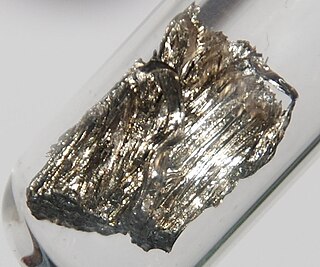
Samarium is a chemical element; it has symbol Sm and atomic number 62. It is a moderately hard silvery metal that slowly oxidizes in air. Being a typical member of the lanthanide series, samarium usually has the oxidation state +3. Compounds of samarium(II) are also known, most notably the monoxide SmO, monochalcogenides SmS, SmSe and SmTe, as well as samarium(II) iodide.

Samarium(II) iodide is an inorganic compound with the formula SmI2. When employed as a solution for organic synthesis, it is known as Kagan's reagent. SmI2 is a green solid and solutions are green as well. It is a strong one-electron reducing agent that is used in organic synthesis.

1,10-Phenanthroline (phen) is a heterocyclic organic compound. It is a white solid that is soluble in organic solvents. The 1,10 refer to the location of the nitrogen atoms that replace CH's in the hydrocarbon called phenanthrene.
Metal acetylacetonates are coordination complexes derived from the acetylacetonate anion (CH
3COCHCOCH−
3) and metal ions, usually transition metals. The bidentate ligand acetylacetonate is often abbreviated acac. Typically both oxygen atoms bind to the metal to form a six-membered chelate ring. The simplest complexes have the formula M(acac)3 and M(acac)2. Mixed-ligand complexes, e.g. VO(acac)2, are also numerous. Variations of acetylacetonate have also been developed with myriad substituents in place of methyl (RCOCHCOR′−). Many such complexes are soluble in organic solvents, in contrast to the related metal halides. Because of these properties, acac complexes are sometimes used as catalyst precursors and reagents. Applications include their use as NMR "shift reagents" and as catalysts for organic synthesis, and precursors to industrial hydroformylation catalysts. C
5H
7O−
2 in some cases also binds to metals through the central carbon atom; this bonding mode is more common for the third-row transition metals such as platinum(II) and iridium(III).

Aluminium acetylacetonate, also referred to as Al(acac)3, is a coordination complex with formula Al(C5H7O2)3. This aluminium complex with three acetylacetone ligands is used in research on Al-containing materials. The molecule has D3 symmetry, being isomorphous with other octahedral tris(acetylacetonate)s.

Cerium(III) acetylacetonate is a compound with formula Ce(C5H7O2)3(H2O)x. It is typically isolated as the trihydrate. Partial dehydration gives the dihydrate, a red-brown solid.

Dysprosium acetylacetonate is a chemical compound of dysprosium with formula Dy(C5H7O2)3(H2O)n.

Europium acetylacetonate is a coordination complex with formula Eu(C5H7O2)3. Although this anhydrous acetylacetonate complex is widel discussed, some sources suggest that it is really the dihydrate Eu(C5H7O2)3(H2O)2.

Gadolinium acetylacetonate is a coordination compound with the formula Gd(C5H7O2)3. This anhydrous acetylacetonate complex is widely discussed but unlikely to exist per se. The 8-coordinated dihydrate Gd(C5H7O2)3(H2O)2 is a more plausible formula based on the behavior of other lathanide complexes. It has also been characterized twice by X-ray crystallography.

Sodium acetylacetonate is an organic compound with the nominal formula Na[CH(C(O)CH3)2]. This white, water-soluble solid is the conjugate base of acetylacetone.

Neodymium(III) acetylacetonate is a coordination compound with the chemical formula Nd(O2C5H7)3. Although many sources discuss this anhydrous acetylacetonate complex, it is the dihydrate Nd(O2C5H7)3(H2O)2 that has been characterized by X-ray crystallography. It commonly occurs as a white powder. Upon heating under vacuum, other dihydrated lanthanide trisacetylacetonates convert to oxo-clusters M4O(C5H7O2)10. This result suggests that Nd(O2C5H7)3 may not exist.

Holmium acetylacetonate is a coordination compound with the formula Ho(C5H7O2)3. This anhydrous acetylacetonate complex is often discussed but unlikely to exist per se. The 8-coordinated dihydrate Ho(C5H7O2)3(H2O)2 is a more plausible formula based on the behavior of other lanthanide acetylacetonates. The dihydrate has been characterized by X-ray crystallography.
Samarium compounds are compounds formed by the lanthanide metal samarium (Sm). In these compounds, samarium generally exhibits the +3 oxidation state, such as SmCl3, Sm(NO3)3 and Sm(C2O4)3. Compounds with samarium in the +2 oxidation state are also known, for example SmI2.

Yttrium acetylacetonate is a coordination compound with the chemical formula Y(C5H7O2)3(H2O)x, or Y(acac)3(H2O)x for short. The value of x can vary from 1 to 3.

Praseodymium acetylacetonate is a coordination complex with the formula Pr(C3H7O2)3. This purported anhydrous acetylacetonate complex is widely discussed but only the dihydrate Pr(C3H7O2)3(H2O)2 has been characterized by X-ray crystallography.

Erbium acetylacetonate is a coordination compound with the formula Er(C5H7O2)3. This anhydrous acetylacetonate complex is often discussed but unlikely to exist per se. The 8-coordinated dihydrate Er(C5H7O2)3(H2O)2 is a more plausible formula based on the behavior of other lanthanide acetylacetonates. The dihydrate has been characterized by X-ray crystallography.

Thulium acetylacetonate is a coordination compound with the formula Tm(C5H7O2)3. This anhydrous acetylacetonate complex is often discussed but unlikely to exist per se. The 8-coordinated dihydrate Tm(C5H7O2)3(H2O)2 is a more plausible formula based on the behavior of other lanthanide acetylacetonates. The dihydrate has been characterized by X-ray crystallography. Upon attempted dehydration by heating under vacuum, other hydrated lanthanide tris(acetylacetonate) complexes decompose to give oxo-clusters.

Lanthanum acetylacetonate refers to the coordination complex with the formula La(C5H7O2)3. This anhydrous acetylacetonate complex has not been characterized well, but the dihydrate La(C5H7O2)3(H2O)2 has been characterized by X-ray crystallography.

Lutetium acetylacetonate is a coordination compound with the chemical formula Lu(C5H7O2)3, or Lu(acac)3 for short. The complex per se is unlikely to exist, but the dihydrate would be expected based on the behavior of other lanthanide tris(acetylacetonate)s. Consistent with this scenario, It forms adducts Lu(acac)3(phen) and Lu(acac)3(dipy) where phen and bipy are 1,10-phenanthroline and 2,2'-bipyridine, respectively.

Terbium acetylacetonate is a coordination compound with the formula Tb(C5H7O2)3. This anhydrous acetylacetonate complex is often discussed but unlikely to exist per se. The 8-coordinated dihydrate Tb(C5H7O2)3(H2O)2 is a more plausible formula based on the behavior of other lanthanide acetylacetonates. The dihydrate has been characterized by X-ray crystallography. Upon attempted dehydration by heating under vacuum, other hydrated lanthanide tris(acetylacetonate) complexes decompose to give oxo-clusters. The complex can be prepared from terbium salts, acetylacetone, and a base such as ammonia.


















